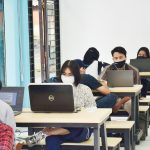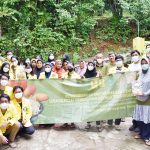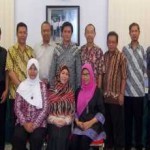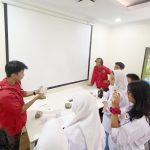DAFTAR SDGS-15
| No. | SDG | Metric | Year | Collaborator | Evidence | Evidence in Public | Statement |
|---|---|---|---|---|---|---|---|
| 1 | 15 | 15. 1 Research on SDG 15 | 2019 | Winarni, N.L., Nuruliawati, N. and Afifah, Z., 2019. Assessment of Surrogate of Ecosystem Health Using Indicator Species and Mixed-Species Bird Flock. Environment and Natural Resources Journal, 17(3), pp.11-18. | https://doi.org/10.32526/ennrj.17.3.2019.18 | Investigation of the use of indicator species as a surrogate for ecosystem health was conducted during 2014 in the periphery of the Bukit BarisanSelatan National Park, Lampung, Indonesia. | |
| 2 | 15 | 15.1 Research on SDG 15 | 2019 | Simbiak, M., J. Supriatna, E.B. Waluyo, Nisyawati 2019. Review Current status of Ethnobiological studies in Merauke, Papua, Indonesia: A perspective of biological-cultural diversity conservation. Biodiversitas 20(12): 3455-3466. | https://doi.org/10.13057/biodiv/d201201 | An ethnobiological study integrating scientific research with awareness of political and ecological issues, loss of biological resources, including indigenous peoples’ struggles over land and resources, identity degradation due to loss of culture and languagein Merauke, Papua. | |
| 3 | 15 | 15.1 Research on SDG 15 | 2019 | Hartiningtias, D., Andayani, N. and Winarni, N.L., 2019. Phenological Pattern and Community Structure of Dipterocarpaceae in Bukit Barisan Selatan National Park, Lampung. In Tropical Ecosystems: Structure, Functions and Challenges in the Face of Global Change (pp. 279-288). Springer, Singapore. | https://link.springer.com/chapter/10.1007/978-981-13-8249-9_15 | A research to showing that dipterocarps in Bukit Barisan National Parks, Sumatra show flowering occurs more than one cycle per year, different from the common dipterocarps’ phenological pattern that usually has mass flowering. | |
| 4 | 15 | 15.1 Research on SDG 15 | 2019 | dos Santos R., L. L. Bridgeman, J. Supriatna, R. Siregar, N. Winarni and R. Salmi. 2019. Behavioural Ecology of Mangrove Primates and Their Neighbours. In: Primates in flooded area: Ecology and Conservation (Eds K. Nowak, A. Barnett, I. Matsuda), p. 125-134, Cambridge University Press, Cambridge, UK. | https://scholar.ui.ac.id/en/publications/behavioural-ecology-of-mangrove-primates-and-their-neighbours-in- | Behavioural Ecology of Mangrove Primates and Their Neighbours. | |
| 5 | 15 | 15.1 Research on SDG 15 | 2019 | Alamgir, M., M.J. Campbell, S. Sloan, A. Suhardiman, J. Supriatna, W.F. Williams 2019. High-risk infrastructure projects pose imminent threats to forests in Indonesia Borneo. Nature: Scientific Reports 2019) 9:140 | https://www.nature.com/articles/s41598-018-36594-8 | Research the potential impacts of this new infrastructure on Bornean forests or biodiversity. It was found that planned and ongoing road and rail-line developments will have many detrimental ecological impacts, including fragmenting large expanses of intact forest. | |
| 6 | 15 | 15.1 Research on SDG 15 | 2019 | Garg, S., Suyesh, R., Das, A., Jiang, J., Wijayathilaka, N., Amarasinghe, A. T., … & Biju, S. D. (2019). Systematic revision of Microhyla (Microhylidae) frogs of South Asia: a molecular, morphological, and acoustic assessment. Vertebrate Zoology, 69(1), 1-71. | https://www.researchgate.net/publication/329773865_Systematic_revision_of_Microhyla_Microhylidae_frogs_of_South_Asia_a_molecular_morphological_and_acoustic_assessment | A study presents a systematic revision of South Asian members of the taxonomically challenging genus Microhyla Tschudi, 1838. | |
| 7 | 15 | 15.1 Research on SDG 15 | 2019 | Asia Pulp and Paper | Riset pembangunan hutan tanaman industri rendah karbon berkelanjutan (Research on the development of sustainable low-carbon industrial plantations) | https://www.goodnewsfromindonesia.id/2019/01/17/mipa-ui-dan-sinar-mas-kerjasama-bangun-budaya-riset-terapan | Research collaboration between APP and ISER FMIPA UI to support APP in becoming world class industry within the low carbon development scheme. |
| 8 | 15 | 15.1 Research on SDG 15 | 2019 | Asia Pulp and Paper | Riset risiko dan kelentingan ekosistem pada hutan tanaman industri di lahan gambut Sumatra (Research on risk and ecosystem resilience in industrial plantation forests on Sumatran peatlands) | https://www.goodnewsfromindonesia.id/2019/01/17/mipa-ui-dan-sinar-mas-kerjasama-bangun-budaya-riset-terapan | Research on risk and ecosystem resilience in industrial plantation forests on Sumatran peatlands. |
| 9 | 15 | 15. 1 Research on SDG 15 | 2020 | Leo, S., Suherman, M., Permatasari, A., Suganda, D., Zulamri, & Winarni, N. L. (2020). Herpetofauna diversity in Zamrud National Park , Indonesia : baseline checklist for a Sumatra peat swamp forest ecosystem. Amphibian & Reptile Conservation, 14(2), 250–263. | https://www.researchgate.net/publication/344025187_Herpetofauna_diversity_in_Zamrud_National_Park_Indonesia_baseline_checklist_for_a_Sumatra_peat_swamp_forest_ecosystem | A survey conducted in Zamrud National Park (ZNP) to determine the herpetofaunal diversity and community in the park. | |
| 10 | 15 | 15.1 Research on SDG 15 | 2020 | Kanishka, S.A., Danushka, A.D. and Amarasinghe, A.T., 2020. A new species of Lankascincus Greer, 1991 (Reptilia: Scincidae) with an overview of the L. gansi group. Taprobanica, 9(1), pp.103-119. | http://www.thasun.info/~file/78_thasun_amarasinghe_new_species_lankascincus_sameerai-7edc8-3546_328.pdf?b | A comprehensive redescription for L. gansi based on three topotypes collected from Udugama, Sri Lanka. | |
| 11 | 15 | 15.1 Research on SDG 15 | 2020 | Krisna, A, N.P., J. Supriatna, M Suparmoko, R. Garsetiasih 2020. Sustainability of Timor Deer in Captivity: Captive Breeding Systemsin West Java, Indonesia. Tropical Conservation Science 13: 1-12. | https://doi.org/10.1177/1940082920915651 | The population of Timor deer (Rusa timorensis), an Indonesian endemic, continues to decline in its natural habitat, so captive breeding could become a source of individuals to bolster wild population. Support for captive breeding programs may be stronger if captive breeding also provided meat for human consumption. | |
| 12 | 15 | 15.1 Research on SDG 15 | 2020 | Chandramouli, S.R. and Amarasinghe, A.T., 2020. On two poorly known, insular skinks, Eutropis tytleri (Theobald, 1868) and E. andamanensis (Smith, 1935)(Reptilia: Scincidae), endemic to the Andaman Islands, India. Taprobanica 9(1): 31-38. | https://doi.org/10.47605/tapro.v9i1.219 | An examination on the holotype of Eutropis tytleri and one of the syntypes of E. andamanensis collected from the Andaman Islands, currently deposited at the Zoological Survey of India (ZSI). | |
| 13 | 15 | 15.1 Research on SDG 15 | 2020 | Amarasinghe, A.T., Karunarathna, D.M.S.S., Campbell, P., Ganesh, S.R. and Vogel, G., 2020. Taxonomy and distribution of Liopeltis calamaria (Günther, 1858)(Reptilia: Colubridae), including redescription of the syntypes. Taprobanica, 9(1), pp.39-49. | https://doi.org/10.47605/tapro.v9i1.220 | Liopeltis calamaria, a rare non-venomous colubrid snake of South Asia, is redescribed. Its syntypes and all the available type specimens of its recognized synonyms are examined, including information about the respective populations found across India and Sri Lanka. | |
| 14 | 15 | 15.1 Research on SDG 15 | 2020 | Amarasinghe, A.T. and Karunarathna, S., 2020. A new diminutive day gecko species of the genus Cnemaspis Strauch, 1887 (Reptilia: Gekkonidae) from Pilikuttuwa, near the capital of Sri Lanka. Taprobanica, 9(1), pp.71-82. | https://doi.org/10.47605/tapro.v9i1.223 | A research on diminutive day geckos of the genus Cnemaspis in Sri Lanka, and based on morphological evidence, a new species belonging to the C. podihuna complex is described herein. | |
| 15 | 15 | 15.1 Research on SDG 15 | 2020 | Amarasinghe, A.A.T. 2020. On a gazelle eating a dove at Dubai Desert Conservation Reserve. Short Communication. Taprobanica 9 (2), pp. 242-243 | https://doi.org/10.47605/tapro.v9i2.241 | A finding about a gazelle eating a dove at Dubai Desert Conservation Reserve. | |
| 16 | 15 | 15.1 Research on SDG 15 | 2020 | Siregar, P. J. Supriatna, R.H. Koetoer, D. Harmantyo. 2020. Borneo orangutan Pongo pygmaeus pygmaeus habitat sustainability and its challenge. | https://iopscience.iop.org/article/10.1088/1755-1315/481/1/012002 | A study aims to evaluate the current condition of landscape sustainability and its challenges in Orangutan Pongo pygmaeus pygmaeus habitat in West Kalimantan, Indonesia, to assist researchers, planners and policymakers to formulate direction of regional development policy. | |
| 17 | 15 | 15.1 Research on SDG 15 | 2020 | Leo, S. and J Supriatna 2020. Morphological variation of Ahaetulla prasina (Boie, 1827) (Squamata: Colubridae) in Indonesia, with an expanded description of the species. IOP Conf. Series: Earth and Environmental Science 481 (2020) 012003 | https://iopscience.iop.org/article/10.1088/1755-1315/481/1/012003/meta | An examination of the most common Ahaetulla species in Indonesia, A. prasina. The tudy aims to explain the morphological variation and analyses pattern of A. prasina population from Sumatra, Java, Kalimantan and Sulawesi mainland. | |
| 18 | 15 | 15.1 Research on SDG 15 | 2020 | Subagyo, A., J Supriatna, N. Andayani, A Mardiastuti and Sunarto, 2020. Diversity and activity pattern of wild cats in Way Kambas National Park, Sumatra, Indonesia IOP Conf. Series: Earth and Environmental Science 481 (2020) 012005 | https://iopscience.iop.org/article/10.1088/1755-1315/481/1/012005/meta | A study that shows Way Kambas National Park is an important habitat for wild cats in Sumatra, although the presence of other rarer cat species in the park, such as golden cat and flat-headed cat still needs to be confirmed by further long-term monitoring study. | |
| 19 | 15 | 15.1 Research on SDG 15 | 2020 | Putra, C.A., Amarasinghe, A.T., Hikmatullah, D., Scali, S., Brinkman, J., Manthey, U. and Ineich, I., 2020. Rediscovery of Modigliani’s nose-horned lizard, Harpesaurus modiglianii Vinciguerra, 1933 (Reptilia: Agamidae) after 129 years without any observation. Taprobanica: The Journal of Asian Biodiversity, 9(1), pp.3-11. | https://doi.org/10.47605/tapro.v9i1.216 | The Modigliani’s nose-horned lizard, Harpesaurus modiglianii Vinciguerra, 1933, is one of the rarest lizards in the world, known only from its single type specimen collected in 1891, from North Sumatra, Indonesia. During explorations of the forests surrounding Lake Toba and its caldera, a population of H. modiglianii was discovered at an elevation of 1,675 m a.s.l., and provide the first data on its habitat. | |
| 20 | 15 | 15.1 Research on SDG 15 | 2020 | Amarasinghe, A.A.T., A. Riyanto, Mumpuni & L.L. Grismer. 2020. A new Bent-Toed Gecko species of the genus Cyrtodactylus GRAY, 1827 (Squamata: Gekkonidae) from the West Bali National Park, Bali, Indonesia. Taprobanica 9 (1), pp. 59-70 | https://doi.org/10.47605/tapro.v9i1.222 | A finding of new Bent-Toed Gecko species of the genus Cyrtodactylus GRAY, 1827 (Squamata: Gekkonidae) from the West Bali National Park, Bali, Indonesia. | |
| 21 | 15 | 15.1 Research on SDG 15 | 2020 | Amarasinghe, A.T., Chandramouli, S.R., Deuti, K., Campbell, P.D., Henkanaththegedara, S.M. and Karunarathna, S., 2020. A revision of Eutropis rudis (Boulenger, 1887), resurrection of E. lewisi (Bartlett, 1895) and description of a new species (Reptilia: Scincidae) from Great Nicobar. | https://doi.org/10.47605/tapro.v9i1.217 | Examination of the syntype series of Eutropis rudis (6 specimens) collected from Sumatra and Borneo, currently deposited at the Natural History Museum, London. | |
| 22 | 15 | 15.1 Research on SDG 15 | 2020 | Chandramouli, S.R., Hamidy, A. and Amarasinghe, A.T., 2020. A reassessment of the systematic position of the Asian ranid frog Hylorana nicobariensis Stoliczka, 1870 (Amphibia: anura) with the description of a new genus. Taprobanica 9 (1): 121-132. | https://www.researchgate.net/publication/344067104_A_REASSESSMENT_OF_THE_SYSTEMATIC_POSITION_OF_THE_ASIAN_RANID_FROG_Hylorana_nicobariensis_STOLICZKA_1870_AMPHIBIA_ANURA_WITH_THE_DESCRIPTION_OF_A_NEW_GENUS | Reassessment of the systematic position of the ranid frog Hylorana (=Hylarana) nicobariensis that, owing to its uncertain phylogenetic position and lack of clear morphological characterisation, has lately been allocated to various Asian and African frog genera | |
| 23 | 15 | 15.1 Research on SDG 15 | 2020 | Danushka, A.D, Kanishka, A.S., Amarasinghe, A.A.T., Vogel, G. & Seneviratne, S.S., 2020. A new species of Dendrelaphis Boulenger, 1890 (Reptilia: Colubridae) from the wet zone of Sri Lanka with a redescription of Dendrelaphis bifrenalis (Boulenger, 1890). Taprobanica, 9 (1), pp. 83-102, pls.30-36 | https://doi.org/10.47605/tapro.v9i1.224 | Examination of the Dendrelaphis bifrenalis populations on Sri Lanka showed that there are two populations that are morphologically different from each other. | |
| 24 | 15 | 15.1 Research on SDG 15 | 2020 | Ganesh, S.R., Amarasinghe, A.T. and Vogel, G., 2020. Redescription of Lycodon travancoricus (Beddome, 1870)(Reptilia: Colubridae), an Indian endemic snake, with a review of its geographic range. Taprobanica, 9(1), pp.50-58. | https://doi.org/10.47605/tapro.v9i1.221 | Redescription of the poorly-known peninsular India endemic colubrid snake Lycodon travancoricus based on its traceable syntype. | |
| 25 | 15 | 15.1 Research on SDG 15 | 2020 | Supriatna, J. M. Shekelle, H. A.H. Fuad, N. L. Winarni, A. A. Dwiyahreni, M. Farid, S. Mariati C. Margules, B. Prakoso , Z. Zakaria 2020. Deforestation on the Indonesian island of Sulawesi and the loss of primate habitat. Global Ecology and Conservation 24 (2020) e01205 | https://doi.org/10.1016/j.gecco.2020.e01205 | An island-wide review of the current extent and rates of deforestation, and the impact this is having on the habitat available to all primates and within macaque hybrid zones in Sulawesi. | |
| 26 | 15 | 15.1 Research on SDG 15 | 2020 | Supriatna, J., S.Leo, B. G. Anugra, A. A. Dwiyahreni, Nurul L. Winarni and C. Margules 2020. Lessons Learned from Training Students to Conduct Primate Surveys. Primate Conservation 34: 217-225 | http://static1.1.sqspcdn.com/static/f/1200343/28367920/1604698771547/PC34_Supriatna_et_al_survey_training.pdf?token=lPmymRA3zYlTv0O0V67uF%2FtkA8E%3D | University students training on field methods for surveying primates at two sites in Java—Gunung Halimun Salak National Park (GHSNP) and Gunung Simpang Nature Reserve (GSNR). The purpose was to train students in standardised repeatable methods for surveying primates in the wild and to provide knowledge on how a primate survey is planned and designed and to teach the methods used to carry them out. |
| No. | SDG | Metric | Year | Collaborator | Evidence | Evidence in Public | Statement |
|---|---|---|---|---|---|---|---|
| 1 | 15 | 15.2 Supporting land ecosystem through education | 2020 | Supriatna, J., S.Leo, B. G. Anugra, A. A. Dwiyahreni, Nurul L. Winarni and C. Margules 2020. Lessons Learned from Training Students to Conduct Primate Surveys. Primate Conservation 34: 217-225 | http://static1.1.sqspcdn.com/static/f/1200343/28367920/1604698771547/PC34_Supriatna_et_al_survey_training.pdf?token=lPmymRA3zYlTv0O0V67uF%2FtkA8E%3D | University students training on field methods for surveying primates at two sites in Java—Gunung Halimun Salak National Park (GHSNP) and Gunung Simpang Nature Reserve (GSNR). The purpose was to train students in standardised repeatable methods for surveying primates in the wild and to provide knowledge on how a primate survey is planned and designed and to teach the methods used to carry them out. |
Belum ada data
Belum ada data







